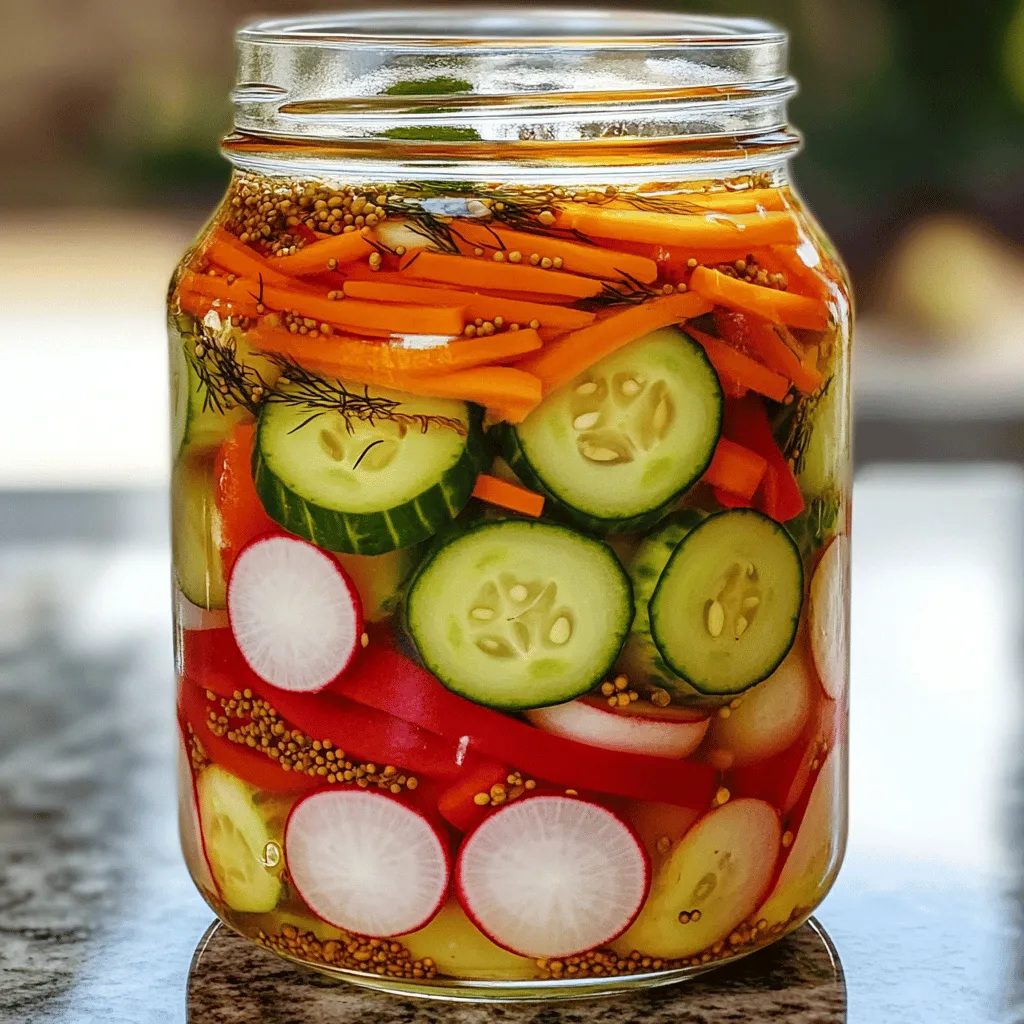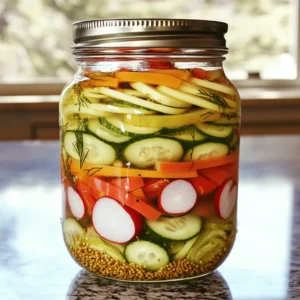Are you looking for a quick, tasty way to preserve your veggies? Easy refrigerator pickled vegetables are the answer! In just a few steps, you can enjoy crunchy, fresh flavors that brighten up any meal. Whether you’re new to pickling or a seasoned pro, this guide will walk you through the ingredients, steps, and tips for perfect pickles. Let’s dive in and learn how to make these delicious bites right at home!
Ingredients
Main Vegetables for Pickling
– 1 cup cucumbers, thinly sliced
– 1 cup carrots, cut into thin matchsticks (julienned)
– 1 cup red bell peppers, sliced into strips
– 1 cup radishes, halved or quartered
When you think about pickling, you may picture cucumbers. However, you can use many vegetables. Each adds a unique crunch and flavor. Carrots bring sweetness. Red bell peppers add color and mild taste. Radishes give a peppery kick. Mix and match to find your favorites.
Pickling Solution Components
– 2 cups water
– 1 cup apple cider vinegar
– 1 tablespoon granulated sugar
– 2 teaspoons kosher salt
– 1 teaspoon garlic powder
– 1 teaspoon dried dill weed (or a few fresh dill sprigs)
– 1 teaspoon mustard seeds (optional, for extra flavor)
The pickling solution is key to flavor. Water and apple cider vinegar create the base. Sugar adds a touch of sweetness. Salt helps preserve and enhances taste. Garlic powder and dill give that classic pickle flavor. Mustard seeds add a nice crunch but are optional.
Essential Tools
– Mixing bowls
– Glass jars or airtight containers
– Whisk
You need a few simple tools. Mixing bowls help combine your veggies. Glass jars or airtight containers keep the pickles fresh. A whisk mixes your pickling liquid well. These tools make the process easy and fun. Remember to have everything ready before you start.
For the full recipe, check out the Quick & Crunchy Pickle Party section above!
Step-by-Step Instructions
Preparing the Vegetables
To start, gather your ingredients. In a spacious mixing bowl, combine sliced cucumbers, carrots, red bell peppers, and radishes. Each vegetable adds a unique taste and crunch. Toss gently to mix them well. This ensures every bite has a bit of everything.
Making the Pickling Solution
Next, whisk together water, apple cider vinegar, granulated sugar, kosher salt, garlic powder, dried dill weed, and mustard seeds if you want extra flavor. It’s important to stir until the sugar and salt dissolve fully. This mixture creates the tangy brine that makes your veggies pop.
Combining Veggies and Pickling Liquid
Now, carefully pour the pickling liquid over the mixed vegetables in the bowl. Make sure all the veggies are fully submerged in the liquid. If needed, add more water and vinegar in a 1:1 ratio. This step is key for even flavor absorption.
Storing the Pickled Vegetables
Finally, transfer your vegetable mixture and pickling liquid into clean glass jars or airtight containers. Seal the lids tightly to keep everything fresh. Place the jars in the refrigerator. Let them chill for at least 24 hours. The longer they sit, the better they taste. Enjoy your crunchy, fresh pickled vegetables!
Tips & Tricks
Achieving the Best Flavor
To get the best flavor, let your pickles sit for a few days. This time allows the veggies to soak up the brine. The longer they sit, the crunchier and tastier they become. Adding fresh herbs can enhance the taste too. Dill, basil, or thyme all work well. Just toss in a sprig or two when packing the jar.
Presentation Ideas
Layering vegetables in jars makes a lovely display. Use a mix of colors for a vibrant look. Place the carrots, cucumbers, and peppers in a way that shows off their hues. You can also use clear jars to showcase this beauty. This eye-catching presentation will impress anyone you serve.
Time-Saving Hacks
Prepping vegetables ahead of time saves you effort. You can cut your veggies a day before pickling. This way, you can whip them up quickly. Doubling the recipe helps too. If you want more servings, just double the ingredients. This lets you enjoy your pickles longer or share them with friends.
For the full recipe, check out the Quick & Crunchy Pickle Party.

Variations
Different Vegetables to Explore
You can use many kinds of veggies for pickling. Some great options include:
– Zucchini: Slice it thin for a crisp bite. It absorbs flavors well.
– Cauliflower: Cut it into small florets. It adds a nice crunch and color.
– Green Beans: Trim the ends and leave them whole. They stay crunchy and bright.
These options give you a chance to mix and match. Each vegetable brings its own taste and texture. Feel free to experiment!
Alternative Pickling Liquids
You can switch up your pickling liquid. Some alternatives include:
– Rice Vinegar: It has a mild taste. Great for a sweeter profile.
– White Vinegar: This is stronger and adds a tangy punch.
– Adjusting sweetness: You can add more or less sugar to fit your taste.
Experimenting with different liquids lets you create unique flavors. Adjusting sweetness can also change the whole vibe of your pickles.
Adding Spices for Extra Flavor
Spices can take your pickles to the next level. Here are some fun options:
– Red pepper flakes: Add some heat for a spicy kick.
– Black peppercorns: They add a warm spiciness and depth.
– Fresh herbs like basil or cilantro: These herbs add a fresh aroma and flavor.
Adding spices can change the taste in delightful ways. Don’t be afraid to get creative with your pickling! For the full recipe, check out the Quick & Crunchy Pickle Party.
Storage Info
Best Practices for Storing Pickled Vegetables
To keep your pickled veggies fresh, always store them in the refrigerator. The cold helps maintain crunch and flavor. I highly recommend using glass jars. They do not hold odors and keep the veggies crisp. Plastic containers can trap smells and affect taste over time. Glass jars also look great and let you see those vibrant colors!
Shelf Life and Signs of Spoilage
Refrigerator pickled vegetables can last up to two weeks. After this period, they may lose their crunch. Keep an eye out for any changes. Look at the color; if it fades, it might be time to toss them. Check for any off smells. If they smell sour beyond the tangy pickling scent, it’s best to discard them. Always trust your senses!
Ideal Serving Suggestions
These pickled veggies shine in many dishes. Add them to salads for a crisp bite. They work well in sandwiches, bringing zest and color. You can even serve them as a lovely appetizer. Just place them on a platter and enjoy! They make a great snack, too. Crunchy, tangy, and refreshing, they are perfect on their own. For more ideas, check out the Full Recipe for more ways to enjoy these tasty delights!
FAQs
How long do refrigerator pickled vegetables last?
Refrigerator pickled vegetables can last for about 2 to 4 weeks. To keep them fresh, always store them in a clean glass jar. Make sure to keep the jar tightly sealed. Check for any signs of spoilage, like off smells or changes in color, before eating. If they smell fine and look good, enjoy your crunchy snacks!
Can I use other types of vinegar for pickling?
Yes, you can use other types of vinegar for pickling. Each vinegar brings a different flavor. For example, rice vinegar is mild and sweet. White vinegar has a sharper taste. You can also try malt vinegar for a richer flavor. Just keep in mind that the taste will change based on your choice of vinegar.
Is this recipe safe for canning?
This recipe is not safe for traditional canning. Refrigerator pickling is different from canning. Canning requires specific methods to ensure safety and shelf stability. With refrigerator pickling, you store your jars in the fridge. This method is great for quick use but does not preserve food long-term like canning.
Can I pickle vegetables without sugar?
Yes, you can pickle vegetables without sugar. Skipping sugar will change the taste. Your pickles will be more tart and less sweet. You can also use sugar alternatives, like honey or agave syrup, for a different flavor. Experiment with what you like best!
Pickling is simple and fun. You learned how to choose veggies and make a tasty brine. You saw the right tools needed to store your pickles safely. Flavor boosts and alternate veggies can add variety to your creations. Remember, letting them sit enhances their taste! Experiment and have fun with colors and flavors. Your pickled vegetables can brighten meals and snacks. Enjoy the crunch and flavor as they bring joy to your table!

